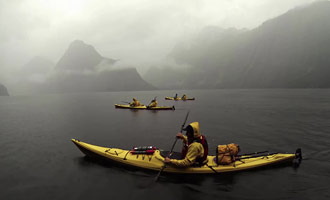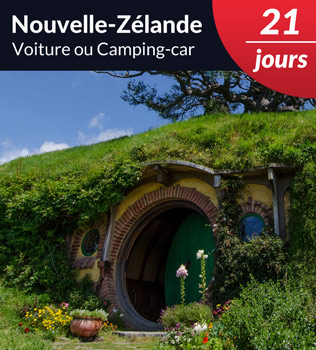
Explore National Parks With a Kayak.
Please contact us and we will help you to organize your trip! It's free and without commitment.
- Read the post
- Details
- Advices
The Practical Guide of the Activity.
- 1One of the Most Popular Sports in the Country.
- 2Kayak for Beginners.
- 3How Does a Kayak Tour Take Place?
- 4The Safety Instructions to Be Observed.
- 5Can I Go Kayaking All by Myself?
- 6The Top 10 Kayak Excursions in New Zealand.
- 7Is Kayaking a Must-Do in New Zealand?
One of the Most Popular Sports in the Country.
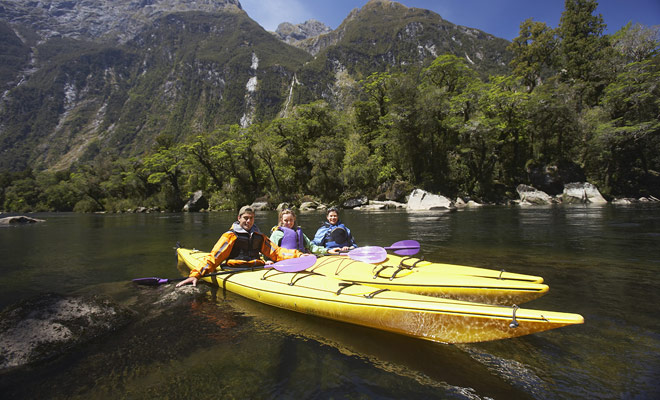
Kayaking is a must-do in New Zealand.
Practicable all year round, kayaking is a very popular activity in New Zealand. Ideal for sailing along the water, this elegant mode of transport makes it possible to approach fur seals and dolphins in their natural environment. It also facilitates access to marine caves and dream beaches deemed inaccessible.
Most guides share the same opinion: the best place to practice kayaking in New Zealand is Abel Tasman.
Ideal for beginners, this national park offers 55 km of sandy beaches, turquoise water and splendid animal reserves.
It's not a surprise if Abel Tasman ranks first in our Top 10 of the kayak in New Zealand.
But before giving the final ranking, I would like to introduce you to the usual course of a kayak trip. I will then help you to choose an itinerary with a local guide.
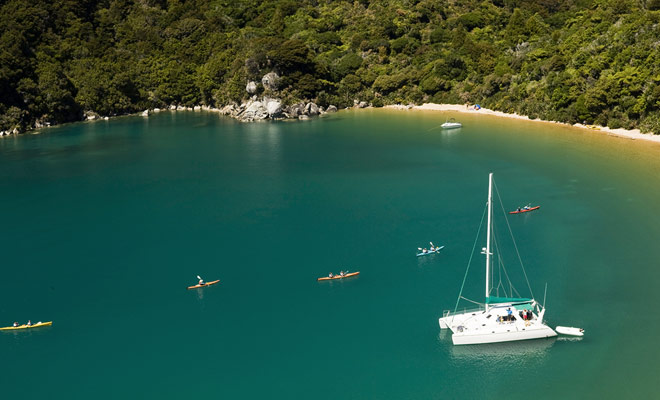
Kayaking is synonymous with freedom in New Zealand.
I know from experience that some beginners are afraid to try kayaking for fear of capsizing.
That's why this article is devoted to the two-seater kayak model, deemed the most stable of all. It is available at every kayak rental companies that I recommend.
If any sporting activity naturally carries a share of risk, the kayak practiced in the company of a guide is a unique and safe experience not to be missed!
In this beautiful country, kayak rhymes with contemplation. Those who seek thrills in rapids or mountain torrents should read our rafting guide first!
Kayak for Beginners.

The kayak is a stable and easy to maneuver.
Do not confuse the sea kayak with its canoeing cousin! The Sea Kayak is designed to offer perfect stability to beginners who explore national parks or descend quiet rivers.
Over time, the design of kayaks has improved with the arrival of new materials such as fiberglass and kevlar. Equipped with a rudder, sea kayaking today has many similarities with traditional ships.
Convenient, the deck net keeps at close hand the accessories that do not need to be stored in the watertight compartment (where supplies and cameras are being kept safe from water).
The presence of a ring on the front makes it easier to tow if necessary.
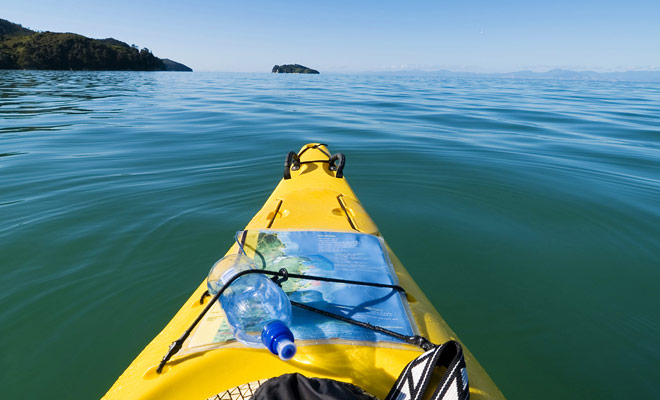
The kayak is not a boat that capsizes easily.
Formerly precarious, the safety of kayaks has been strengthened with the addition of a lifeline that can be gripped.
More importantly, the watertight compartments and the foam have made the boat almost unsinkable and able to withstand the weight of the passengers even under the hypothesis of an ingress of water!
Increasingly handy, the kayak can reach a four knots (7 km / h) speed when the two passengers combine their efforts.
It is precisely on a sea kayak that you will sail in tandem, the majority of agencies offering no other type of model to rent anyway.
I strongly advise against the kayaks without a bridge that are nicknamed “sit on top”, often used for coastal navigation or to gain diving sites. In practice, this model is terribly slow and forces its passengers to fight against the wind that constantly alters the orientation of the kayak.
Essential equipment for kayaking
The equipment is usually provided by the organizers, but here is a list of clothes and accessories essential to the smooth running of a kayak excursion:
- T-shirt
- Shorts
- Sandals
- Hat or cap
- Sunglasses
- Solar cream
- Swimsuit
- Beach towel
- Anti-mosquito repellent or anti-sandflies (depending on the region)
- Bottle of water
- Sandwich (unless optionally packed lunch option)
- Vitamin bars
How Does a Kayak Tour Take Place?

Mandatory equipment includes a lifejacket.
A kayak excursion always starts with a presentation of the itinerary and the instructions to be respected. The guide then assigns the kayaks to the participants and explains how they work. Putting lifejackets is not a rocket science, but they must be properly adjusted so as not to hinder movements.
Feets with sand between the toes facilitate the birth of blisters if the foot holds are improperly set up.
Do not take any risks, and come with beach sandals or wear waterproof clothes for prevention.
Some people do not pay attention to the safety rules, but they feel more concerned when the monitor presents the maneuver to escape from a kayak in case of emergency. This is an important matter, and I will address the subject later.

The basics of kayaking are easy to learn.
You will first learn to settle yourself properly on board. Place your feet on the wedges whose positions are to be adjusted according to the length of your legs. A waterproof elastic skirt adjusts around the waist and then adapts to the opening of the hull to prevent the water from rushing into the kayak (don't panic: you just need to pull on a tongue to detach the skirt in the blink of an eye).

You will be able to familiarize yourself with the kayak on the beach.
Boarding may be a challenge! If the first place is already occupied, it is up to the second participant to put the kayak afloat using the handles fixed on the hull. It is a team effort, and the front passenger has to paddle in the sand to stabilize the kayak (your guide will help if necessary).
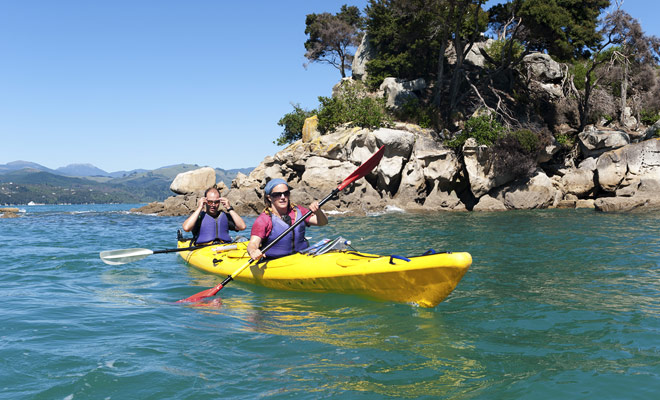
To make good progress in tandem, you must paddle in rhythm.
Maneuvering the rudder is child's play, but it takes practice to paddle and distribute tasks efficiently properly on board.
Synchronization and steady rhythm outweigh strength. Disordered movements waste energy and give blisters to the hands.
On the contrary, you should avoid placing your paddle too deeply in the water and keeping it as close as possible to the kayak.
To go fast in a kayak, one just need to paddle in rhythm!
As for the disembarkation, it is of all the most amusing maneuver. You just need to accelerate to the maximum until your kayak come to run aground in the sand in the middle of the waves.
The Safety Instructions to Be Observed.
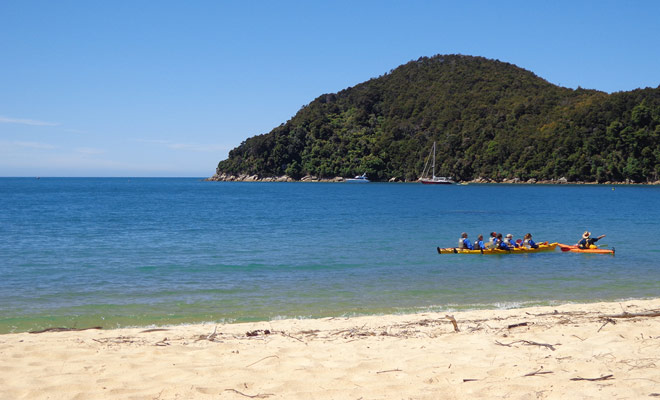
If you have never done a kayak, start with a guide.
It is no coincidence if the kayaks are painted yellow, a tint that stands out clearly on the surface of the water. The monitors opt for red models in order to be easily identified by the members of the group for which they are responsible.
Check out the nearest iSite before departure and do not give exaggerated confidence to the weather forecast of the previous day: a distant rain can turn a peaceful river into rapids in a few minutes.
But it is time to talk about the subject that you all expect: what should you do if the kayak capsizes! Of course, kayaking would not have become so popular if it was implying a constant risk to drown.
However, the maneuver to follow in case of emergency can’t be invented at the last minute and must be repeated beforehand on the beach.

The instructor explains how to paddle and get out of the kayak.
One presses the palms of the hands on the hull behind oneself without turning around and one pushes on the arms. The body of the passenger follows naturally and is freed from the kayak. The simplicity of the maneuver and its speed of execution almost always reassure beginners. But do not forget to detach the elastic skirt by pulling on its tongue!

Kayaking is the perfect way to approach fur seals.
Anyway, the kayak is stable enough not to capsize easily even when a curious fur seal invites himself on board (which sometimes happens in Abel Tasman National Park). The weight of the passengers brings a real stability, but one must always adopt a calm behavior by fixing the horizon. And one do not need to turn himself to communicate with the rear passenger!
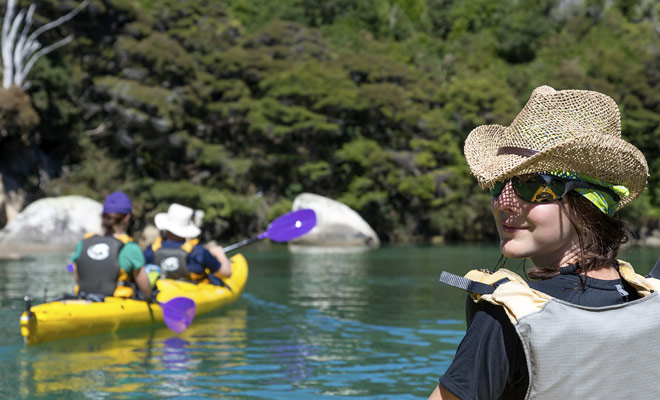
Beware, kayaking can expose you to sunburn.
In reality, the worst enemy is basically the sun... The ozone layer is thinner over New Zealand. Sunburn grows faster without cap and sun cream because the sea breeze provides an illusion of freshness.
Can I Go Kayaking All by Myself?
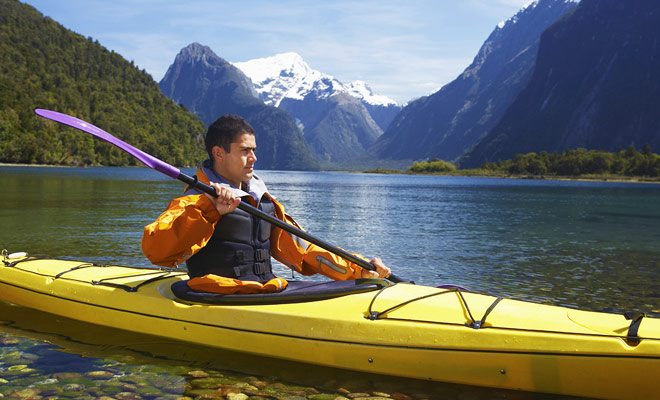
Kayaking is still a sport and requires a minimum of learning.
Renting a kayak for a first solo excursion is a risky behavior. Basic notions can be learned easily, but experience is gained through practice. To be able to deal with any situation, an occasional outing from time to time is not enough..
For it is precisely the panic which is the origin of accidents.
How to behave if a fur seal invites itself on the kayak?
What if the current drives the kayak offshore? Only sailors with at least some experience will know how to react in such occasions.
Bad reflexes and inappropriate postures can spoil the experience!
A half day of kayaking with wrong paddling movements is more than enough to give body aches and blisters.

With a guide, kayaking is easy.
Although not necessarily refractory to the presence of a guide, some people prefer to avoid group visits.
There is nothing to fear, however, because the kayak excursions take place in small groups so that the guide can intervene quickly if needed.
In addition, the kayak instructor does not just teach the maneuvers!
He is an expert who knows the region perfectly and can tell many Maori legends. One often learn more about the culture of the country during a kayak excursion than during the visit of a museum!
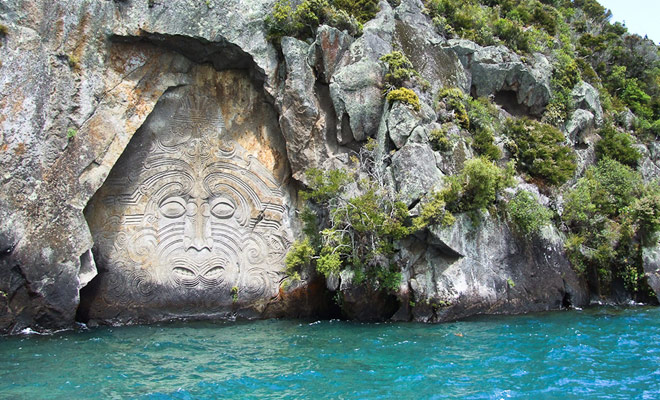
The kayak allows to reach places that are usually inaccessible.
But if one has already practiced the kayak on numerous occasions, it becomes possible to do without a guide. A freedom that implies a greater responsibility.
It is necessary to study the route carefully, and to ask to the rental company where the marine currents are located and their advice about sailing in the region.
Having already practiced the kayak does not exempt you from studying the itinerary.
Note that for navigation on a river, the starting point is usually set at the level of the rental shop. On the other hand, in national parks like Abel Tasman, you have to take a water taxi to get to the starting point with the kayak and return it at the end of the day to a meeting point agreed in advance.
The Top 10 Kayak Excursions in New Zealand.
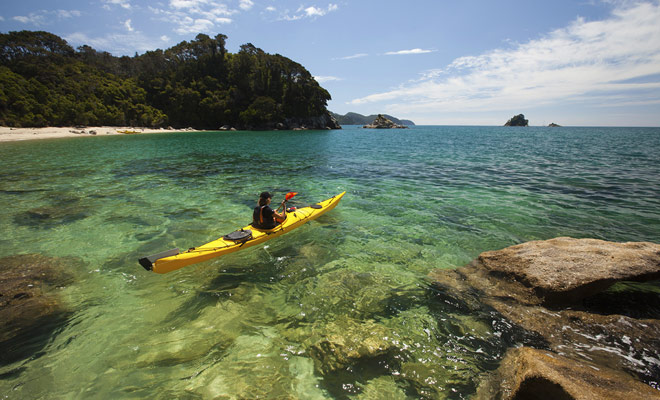
Difficult to imagine a stay in New Zealand without kayaking.
We are proud to present our selection of the top 10 kayak outings in New Zealand. There are, of course, many others, but the ones we have chosen are truly extraordinary and offer the best value for money.
All excursions take place with a maximum of ten participants, and with the presence of a professional kayak instructor. In the event that an organizer is fully booked, I also give you the names of a competitor who proposes a similar activity.
Because they constantly vary according to the seasons and the number of participants, you will forgive me not to reproduce here the schedules of these activities. But you can find them easily on the official websites of the companies.
You should book directly on the Internet and not on location where prices are usually increased. Please note that discounted rates for young people under fifteen years old (sometimes under 12 years old) are not systematic.
Abel Tasman National Park (South Island)

The park of Abel Tasman offers the most beautiful excursions.
If you must do only one kayak excursion during your stay, this is the one! Beaches of orange sand, lagoons, spectacular rock formations and even fur seals!
Abel Tasman Kayaks offers many outings that can mix hiking and kayaking. The water taxi boat shuttles are an ideal solution for the traveler who wants to explore a specific part of New Zealand's most famous national park. Even on a half day, it is an activity impossible to circumvent.
| ACTIVITY | RATE |
|---|---|
| Full day | $220 |
| Half day kayaking | $130 |
| Half day kayaking and hiking | $110 |
If Abel Tasman Kayaks is fully booked, here are the alternatives:
Milford Sound (Fiordland, South Island)
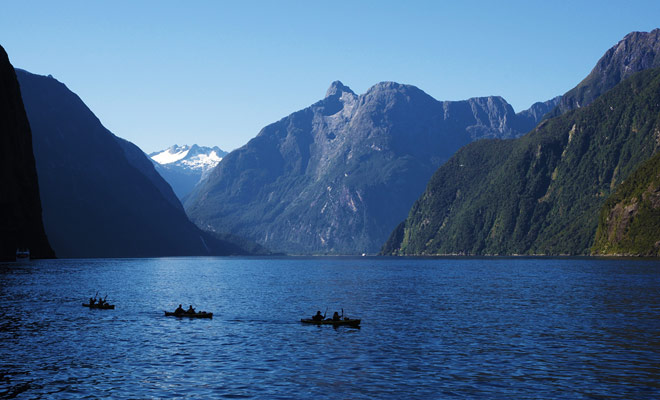
Exploring the Milford Sound by kayak offers special moments.
Kayaking on the Milford Sound gives the feeling of living a dream awake. The presence of dolphins and sea lions brings a touch of magic, but it is necessary to take into account the capricious weather of the fjord: It falls seven meters of rain in the Fiordland every year!
The excursion is very likely to take place in the rain.
Never mind ! The Stirling and Lady Bowen falls are even more beautiful in these conditions and you can count on the team of “Rosco Milford Kayaks” to spend an unforgettable day.
However, you need to come early in the morning. I don't recommend the “Easy Rider” formula, with has an unbeatable price but which lasts only two hours! Even if it means to paddle under the rain, you should book a longer excursion.
| ACTIVITY | RATE |
|---|---|
| Full day | $179 |
| Morning | $149 |
If Rosco Milford Kayaks is fully booked, here are the alternatives:
Cathedral Cove (Coromandel, North Island)

Join the beach of the World of Narnia by kayak.
The kayak tours in the Te Whanganui-A-Hei Marine Reserve alternates coastal sailing along limestone cliffs and exploration of marine caves! Some visitors even report having seen orcas swimming in the turquoise water of the Coromandel Peninsula!
The highlight of the visit is the beach ofCathedral Cove and the discovery of its arch sculpted in the rock. It was here that the opening sequence of the “World of Narnia 2, the Prince Caspian” was shot. Once the kayaks are stranded in the fine sand, the guide from “Sea Kayak Tours” will serve you hot chocolate and cappuccinos.
If you opt for a half-day tour, prefer the morning session, when the waters are calm. At this moment of the day, the rising sun makes the cliffs glow, and the beach of Cathedral Cove is not yet invaded by the tourists.
| ACTIVITY | ADULT | CHILD |
|---|---|---|
| Full day | $160 | $120 |
| Half Day | $95 | $65 |
Bay of Islands (Northland, North Island)
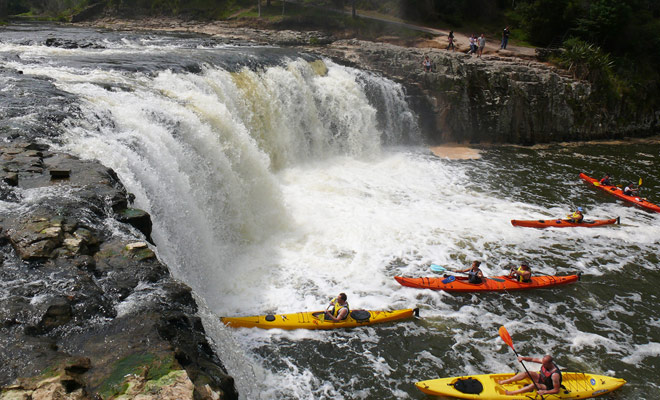
The excursion to the Haruru Falls takes place in a kayak.
The Bay of Islands was once a den of bandits and at the origin of terrible conflicts between Maoris warriors and British settlers. The spirit has changed, and today people come here to enjoy peaceful kayak trips to approach dolphins, seals and penguins.
“Bay of Islands Kayaking” is based in Paihia, the main tourist town and Russell, one of the most beautiful villages in New Zealand.
I recommend you to kayak on the Waitangi River up to the Haruru Falls. Maori legends and the History of the colonial wars are told by the guide during a tour that can even be made at night under the celestial vault.
| ACTIVITY | RATE |
|---|---|
| Full day | $150 |
| Morning | $80 |
If Bay of Islands Kayaking is fully booked, here are the alternatives:
Doubtful Sound (Fiordland, South Island)

The kayak is recommended for exploring the Doubtful Sound.
Excursions to the Doubtful Sound by Sea Kayak Fiordland are planned over a minimum of two days.There is no day or half-day excursion, as it takes at least four hours of boat and road trips to reach the shores of the fjord.
Each day includes about five hours of kayaking in a breathtaking landscape. The region's record rains feed hundreds of waterfalls and you will be almost alone to enjoy the show.

The exploration of fjords in kayak is more pleasant than by boat.

A Kayak tour in the Doubtful Sound on the South Island of New Zealand.
A film by Stoked for SaturdayBetween the islands that serve as a refuge for birds, the dolphins and the curious fur seals that venture near the kayaks, you are not at the end of your surprises.
At nightfall, the small group of campers admire the stars while listening to the sound of the crackling fire and the distant songs of birds that resonate in the fjord.
A fantastic experience, certainly the most intense of our Kiwipal rankings.
Beginners are welcome, but to embark on such a long (2 to 5 day) outing, it is better to have already tested its limits before, so that the adventure does not turn into a bad episode of reality TV.
| ACTIVITY | RATE |
|---|---|
| Two days | $399 |
| 3 to 5 days | On request |
Marlborough Sounds (South Island)

The Marlborough by kayak is pure happiness.
The Marlborough Sounds has more than 1500 km of paradisiacal coastline where dolphins, penguins and fur seals swim in a water that alternate dark-green and turquoise colors.
A simple glance on the map is enough to realize that the kayak is the best option to explore the area if one does not want to hike on foot for several days.
Unknown to travelers, as difficult to access, the Marlborough Sound is an authentic wonder of New Zealand.
Marlborough Sounds Adventure Company offers day trips to Queen Charlotte in the morning or early afternoon.
The most interesting option is to book a water taxi to reach Ngakuta Bay and then return to Picton by kayak.
| ACTIVITY | RATE |
|---|---|
| Full day | $130 |
| Half day | $95 |
If this company is fully booked, here are the alternatives:
Kaikoura (Canterbury South Island)

The kayak in Kaikoura allows you to approach the dolphins.
The Kaikoura Peninsula is renowned for its whale-watching excursions. Of course, one can't take the risk to approach these gigantic mammals by kayak, but the peninsula offers other attractions.
The kayak allows above all to approach hundred dusky dolphins.
The colony of fur-seals, albatrosses and blue penguins are additional reasons to sign up for an outing organized by Kaikoura Kayaks. Especially since the company has won the award for the best kayak tour of New Zealand three times.
| ACTIVITY | ADULT | CHILD |
|---|---|---|
| Half day | $95 | $70 |
Queenstown (Otago, South Island)

Join the islands of Queenstown's Wakatipu Lake by kayaking.
The landscapes of Queenstown that one can admire in the Lord of the Rings are even more impressive when venturing on Lake Wakatipu.
And yet, in this region where jet boat is king, kayaking is not always appreciated as it should be.
Kayaking on a lake does not mean there is an absence of danger!
Here too, the presence of a guide is essential for the true beginners. “Queenstown Sea Kayaks” offers many excursions to Pig and Pigeon Islands with experienced instructors.
| ACTIVITY | ADULT | CHILD |
|---|---|---|
| Full day | $249 | $179 |
| Half day | $139 | $99 |
If Queenstown Kayaks is fully booked, here are the alternatives:
Akaroa (Canterbury, South Island)
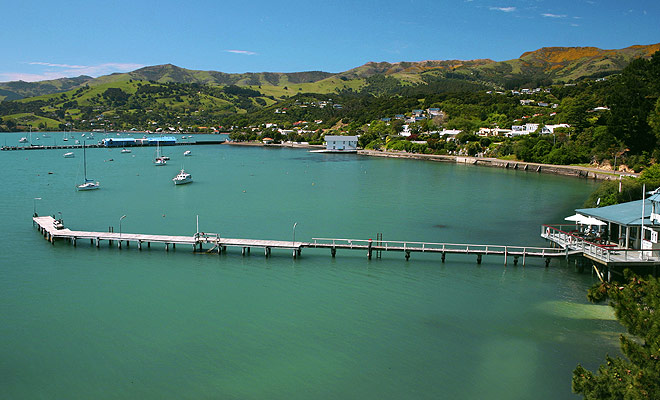
The Banks Peninsula and its dolphins are waiting for you.
The South Island of New Zealand has almost belonged to France. The amazing story of this missed rendezvous is reported in detail in a Kiwipal article about Akaroa, but the guides from “Akaroa Kayaks” will tell you the story better than me.
A kayak excursion to the Banks Peninsula is often the perfect opportunity to complete a trip to New Zealand.
The verdant hills and the presence of the dolphins are enough to make you forget that in a few hours you'll take a plane for an interminable return flight.
| ACTIVITY | RATE |
|---|---|
| Full day | 249 $ |
| Half day | 125 $ |
Punakaiki (West Coast, South Island)
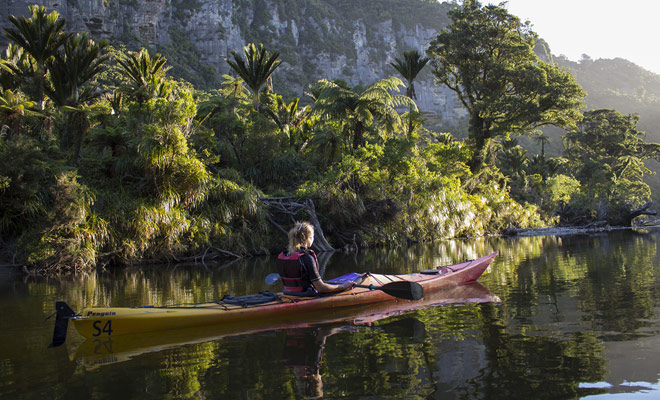
The river pororari and its landscapes worthy of Jurassic Park.
Lost midway between Abel Tasman and the glaciers of the Southern Alps, the Paparoa National Park is Kiwipal team's favorite.
A wonder little known of most travelers that often come here just to see the Pancakes Rocks., then leave after a short break.
River Kayaking proposes to go up the Pororari River in a natural setting that evokes the lost world of Jurassic Park.
Only dinosaurs are missing if one would recreate the distant era when New Zealand was still attached to the Gondwana supercontinent.
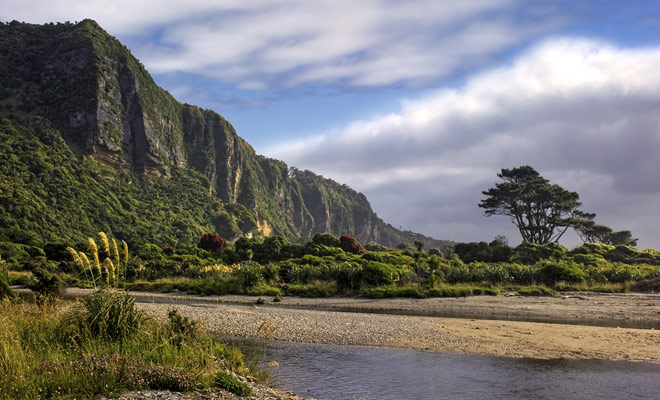
The kayak gives access to a wild and preserved nature.
The small number of hotels available in the village of Punakaiki requires booking well in advance for a visit during the high season. However, kayaking is rarely complete and can be booked on site at the last minute (depending on the weather which is often rainy on the West Coast).
| ACTIVITY | RATE |
|---|---|
| Half day | $70 |
If this company is fully booked, here are the alternatives:
Is Kayaking a Must-Do in New Zealand?

Do not leave New Zealand without having tried the kayak.
If you have the soul of a Robinson Crusoe, kayaking will be the best discovery of your trip in New Zealand. Renting a two-seater kayak cost only $50 per passenger! This is a very cheap sport in a country where activities are often overpriced.
Can we leave New Zealand without having practiced kayaking? That seems inconceivable! But some people are in search of thrills that they will find more easily in a rafting descent than in a peaceful kayak ride. It's up to you!
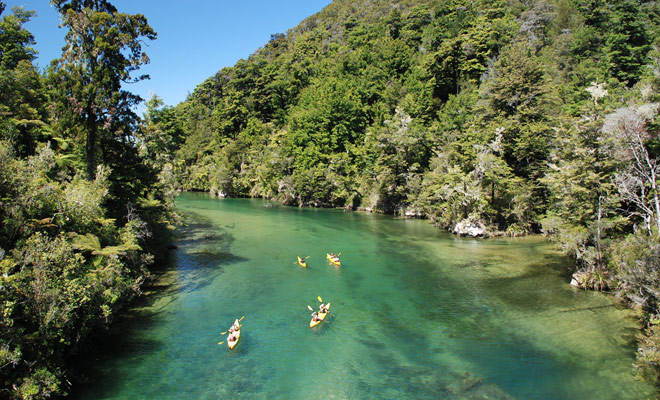
The kayak offers a different view on nature.
It is difficult to leave the paradisiacal beaches, and the feeling of freedom provided by the kayak. I particularly recommend alternating hiking and kayaking, by booking water taxi boat companies (even if their rates are sometimes excessive).
The kayak offers a unique view of the landscape and places you at the very heart of nature. The mythical places of New Zealand such as Milford Sound are infinitely more interesting to explore at few centimeters above sea level, rather than on the deck of a soulless cruise ship.
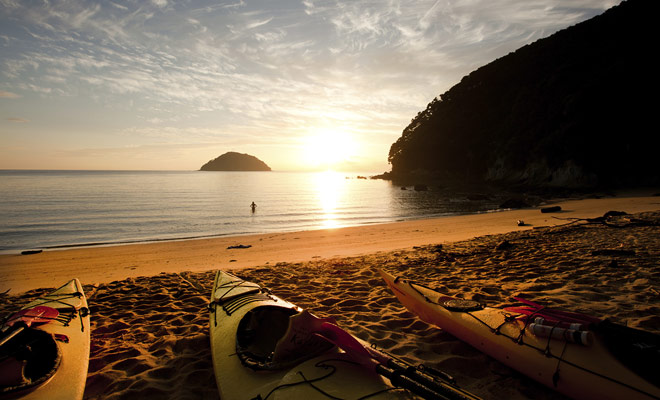
You can easily combine kayaking and camping.
Do not forget that guided tours are a must for beginners.
But nothing prevents you to practice before coming, if you want to go on an adventure with your kayak in the Abel Tasman Park. It is possible to learn how to paddle in your own country first.
If I have properly fulfilled my mission, this article has provided you with all the practical information to organize your future kayak trip. If you still have any questions, I invite you to contact our friend Ben the Kiwi who has been paddling happily since his childhood.


Questions & Answers.

What can I do for you? Kayaking is one of those rare activities that are suitable for both beginners and top-level athletes. I can give you tips to prepare your trip.
- How much does a kayak rental cost?
A two-seater kayak costs $100 a day, knowing that single-seat kayaks are rarely rented for safety reasons.
- What is the minimum age for kayaking?
Among most companies, the minimum age for joining an exit varies between 8 and 14 years. But excursions to wild and isolated environments such as Doubtful Sound requires a minimum age of 16 years.
- Are there family kayaks?
There are sometimes kayaks for rent with a central place for a child.
- Can I sign up for a kayak tour if I can't swim?
You will not be surprised to learn that it depends on the path taken. To the extent that you wear a life jacket and you move with a guide, some companies are tolerant on swimming capacities. I do not share this approach, and I consider that any activity practiced at sea should require knowing how to swim.
- Can we learn the basics of kayaking on the Internet?
The theory will never replace practice, but the two are complementary. There is a remarkable website to study the basic movements.Kayak guide


